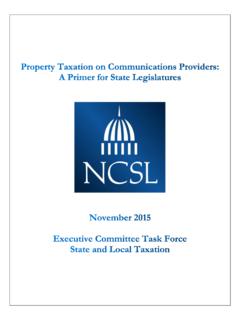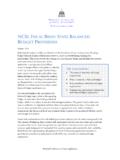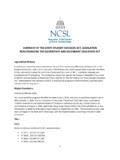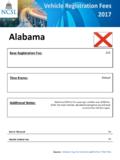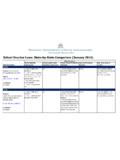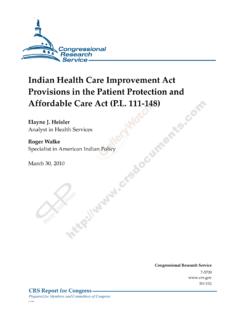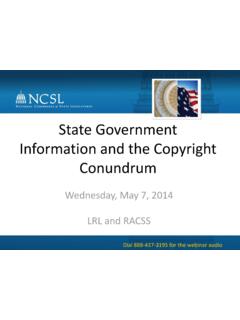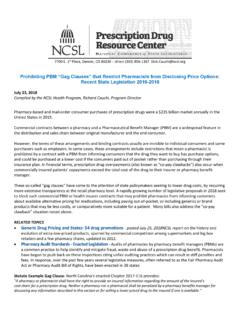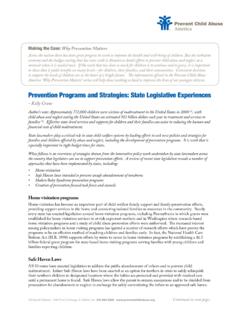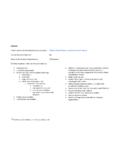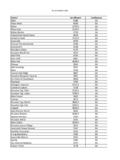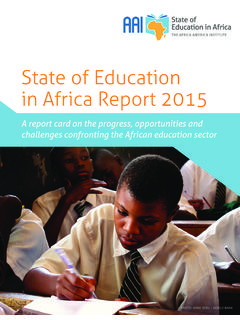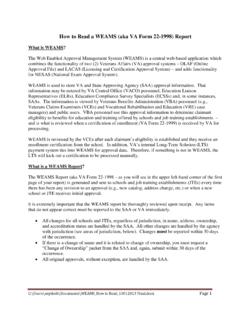Transcription of Charter School Finance - Legislative News, Studies …
1 Charter School Finance By Yilan Shen and Alexander Berger February 2011. C. harter schools are growing rapidly nationwide. Since the first Charter School law passed in Minnesota in 1991, forty states and the District of Columbia have passed laws allowing the publicly funded, private- Charter Schools in the states ly managed and semi-autonomous schools of choice. Charter schools now educate more than 3 percent of all public School students, and the proportion Charter schools are publicly funded, of students enrolled continues to increase at more than 10 percent a privately managed and semi-auton- omous schools of choice. They do not charge tuition. They must hold As with traditional public schools, funding for Charter schools varies signifi- to the same academic accountability cantly across states and The central question in most debates about measures as traditional schools. They Charter School funding is the level of funding.
2 Some claim it is unfair that receive public funding similarly to tra- charters receive less funding per pupil than traditional public schools, while ditional schools. However, they have others argue that the different nature of Charter schools justify lower funding. more freedom over their budgets, (Funding for Charter School facilities is addressed in a separate NCSL brief.) staffing, curricula and other opera- tions. In exchange for this freedom, they must deliver academic results How Are Charter Schools Funded? and there must be enough communi- ty demand for them to remain open. Charter schools are funded primarily by public money, similarly to the ways traditional public schools are funded. Public schools are funded by a combina- The number of Charter schools has continued to grow since the first char- tion of local and state funding; most local funds are raised through property ter law was passed in Minnesota in taxes.
3 This strategy historically has produced significant inequalities in the 1991. Some have delivered great aca- amount of funds available for School districts. Districts that contained less demic results, but others have closed valuable real estate could not collect as much money through property taxes, because they did not deliver on prom- even though their tax rates are sometimes significantly higher than wealthier ised results. districts. During the past 40 years, School Finance reforms have shifted more Because state laws enable and govern of the funding burden onto states , which has resulted in funds being more Charter schools, state legislatures are equally distributed among Almost every state, however, continues important to ensuring their quality. to allow some variation in district revenue based on local property taxes, while allocating state funds to districts based on the number and characteristics of This series provides information students The complex mix of state and local funding upon which about Charter schools and state poli- traditional public schools rely explains some of the complexities in charters cy topics, including Finance , authori- zation, limits to expansion, teaching, School funding.
4 Facilities and student achievement. As publicly funded schools, Charter schools receive money for the students they enroll. When a student enrolls in a Charter School , the money follows him or her from the resident School district. A main difference between char- national conference of State legislatures national conference of State legislatures 1. ter schools and traditional schools is that charters are grant- Types of Charter Funding ed budgetary autonomy in exchange for educational results. Defenders of traditional public schools are concerned that Although Charter schools in every state are funded based Charter schools are taking money away from those schools. on the number of pupils they enroll, the amount of per- Simply having one less student does not proportionally de- pupil funding for Charter schools can vary significantly crease the burden on a district. It likely still needs the same within and across states .
5 states have shaped three differ- number of teachers, other staff, the same facilities and the ent types of funding formulas for Charter schools based same instructional materials. However, losing students to a on the student's resident district, the authorizer or the Charter School or another traditional School have the same statewide effects and traditional schools have always had to adjust to enrollment changes. One strategy funds Charter schools based on the per-pu- pil revenue of districts in which their students reside. It is If a student transfers from a traditional public School to a used in eight states . These states require districts to pass Charter School , advocates argue the full amount of money along a portion of both state and local Because that would have been spent for that student at the tradition- each student brings a portion of home district spending, al public School should move to the Charter School .
6 Char- a Charter School could receive different amounts of mon- ter advocates hold that districts receive funds to educate a ey for different students. Conversely, the same amount certain number of students. When that number declines, it of public funding will follow a student wherever he or makes sense that their funding also should decline. she decides to enroll in a Charter School . Thus, a student whose parents and neighbors are taxed at high local rates To give districts time to adjust to decreasing funding, some can carry a larger amount of funds anywhere in the state. states have adopted hold harmless provisions. Allocating additional funds to districts that lose students to Charter The second type of formula is based on the per-pupil rev- schools helps them adjust to lower funding levels. Massa- enue of the authorizer. It is the most common formula as chusetts, for instance, provides extra funds to a district that it is used in 29 states .
7 In most cases, because authorizers loses a student to a Charter School for six years, gradually are traditional School districts, this strategy is similar to decreasing the funding during that time. Over the six year the first. It diverges, however, when students attend char- period after a student moves to a Charter School , the dis- ter schools outside their home district or when Charter trict will have received a total of more than twice the state's schools are authorized by non-district entities. For exam- annual per-pupil These types of provisions ple, the authorizer can be an institution of higher educa- soften the effects of losing per-pupil revenue on traditional tion. Under this formula, Charter schools receive money School districts. However, Charter schools were originally en- based on the authorizing district's revenue. Colorado visioned to be drivers of competition. If the goal is to follow uses a variant of this approach to fund its Charter schools.
8 The original Charter concept, some argue these provisions It requires School district authorizers to pass on to Charter may dampen true competition. schools 100 percent of their per-pupil revenues, except for up to 5 percent that is spent on administrative costs associated with authorizing the Charter School . If the au- thorizer is the Colorado Charter Institute, a non-district authorizer, the Charter School receives the same amount of funding as the district where it is located. Colorado al 2 national conference of State legislatures lows districts to raise more money by overriding certain local Tradeoffs property tax limits, but does not require the resulting funds to be distributed to Charter schools within a district. Thus, Each of the Charter School funding strategies comes with Charter schools, on average, have 15 percent less revenue per- tradeoffs. By funding a student's Charter School based on his pupil than traditional public or her home district's revenue, a state creates an incentive for Charter schools to draw students from a high-revenue dis- The third formula uses a statewide per-pupil allocation.
9 Trict. Similarly, by funding a student's Charter School based Used in five states and the District of Columbia, it provides on the district that authorizes the Charter , a state creates an Charter schools the same funding wherever they are located incentive for Charter schools to be authorized by a high-reve- within the state and wherever their students reside. Minne- nue district. However, such funding mechanisms also ensure sota uses this formula and funds Charter schools at almost ex- that the amount of money available to educate a student is actly the district level when statewide averages are compared. comparable, whether at a traditional or Charter School . By However, when individual Charter schools are compared with using a statewide per-pupil allocation, a state decreases in- their district counterparts, it is estimated a Minnesota char- centives for Charter schools to serve students in high revenue ter School receives about 13 percent less revenue per-pupil and high need urban districts.
10 The Charter schools in those than the district in which it is One reason for this districts would be receiving the average per-pupil funding in disparity is Charter schools in Minnesota are disproportion- the state. That average is still less than the funding received ately located in urban districts that have large property tax by traditional counterparts with higher than average fund- bases and, therefore, high local revenues. Some advocates are ing. Also, it might be less than what is needed to educate concerned that the average Charter School is still at a disad- disadvantaged students. This type of funding mechanism re- vantage in these cases, despite efforts written in law to fund sults in different amounts of money available for a student's Charter schools more equitably. education based on whether he or she chooses a Charter or traditional public School . What Is the Basis for Charter School Funding?
